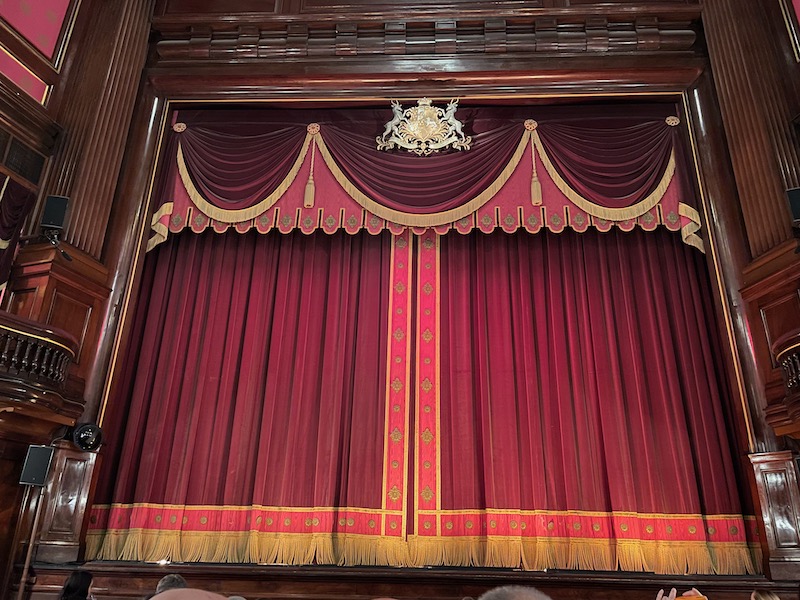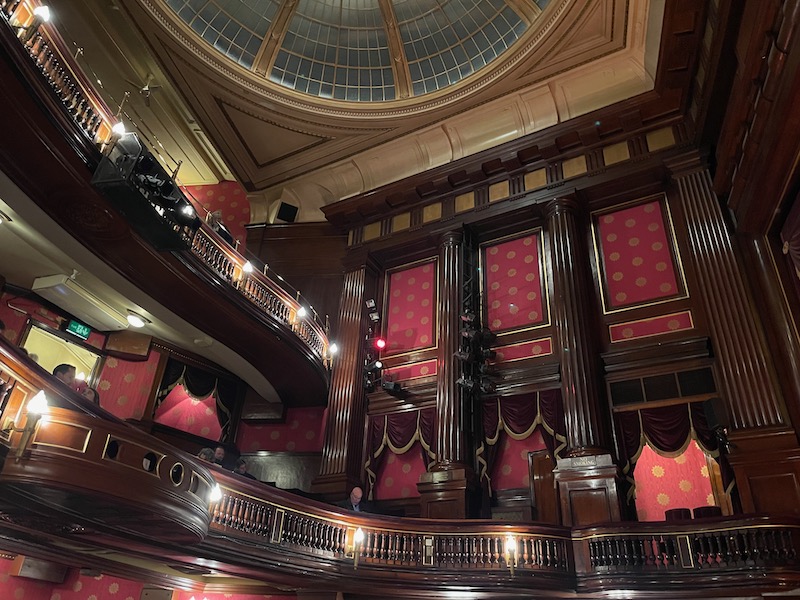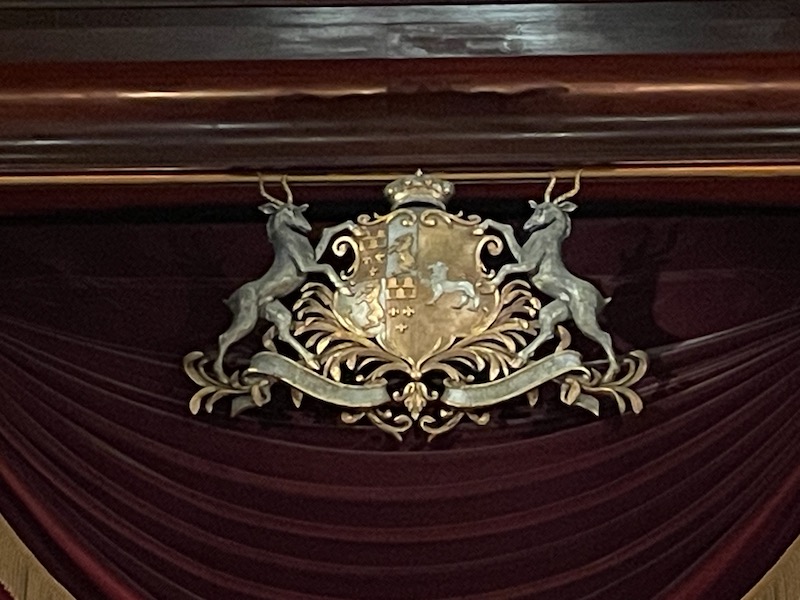Our Blog - London 2025 Day 2
We seem to stay at a different hotel each time we are in London, and this visit was no different. We always want to be near the West End for the shows and have tended to stay at a hotel that is convenient to the Elizabeth line, the new London Underground line that opened in 2022. Well ... I guess it is not "officially" part of the London Underground ... the Elizabeth line is operated by a separate company, not the Transport for London (TfL) which handles almost all of the public transportation in London. And while the Oyster pay-as-you-go card is not accepted on a portion of the line, it *IS* accepted on the section from Heathrow Airport to central London, so it was pretty easy to get from Heathrow to our hotel.
This time, we stayed within a couple minutes of Leicester Square (heart of the Theater district), Trafalgar Square, Chinatown, and Covent Garden. Not a bad location! I'll start in Trafalgar Square, that is named after the 1805 Battle of Trafalgar, the British naval victory in the Napoleonic Wars over France and Spain. The square is the home of the National Gallery art museum as well as a couple fountains, a bunch of statues, and Nelson's column, which was erected in 1840. This is one of the 4 lions around the base that while they were part of the original design, were only added in 1867.
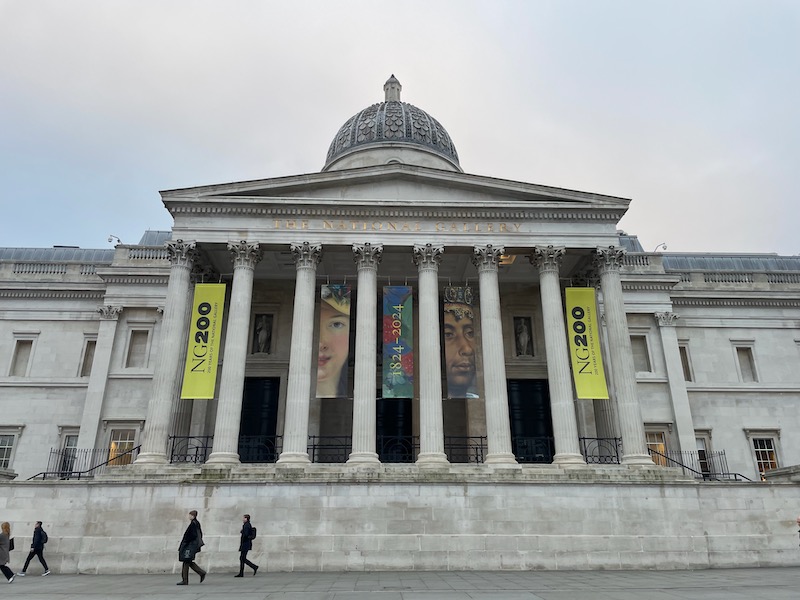
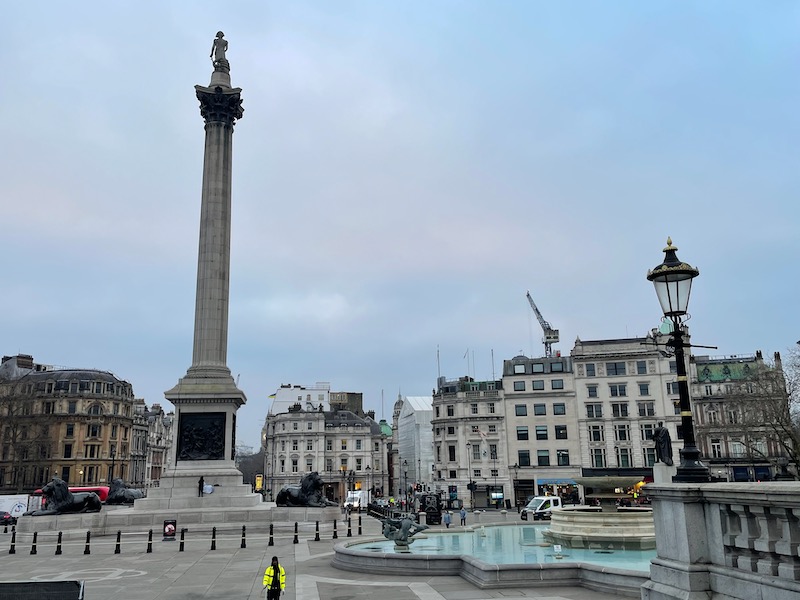
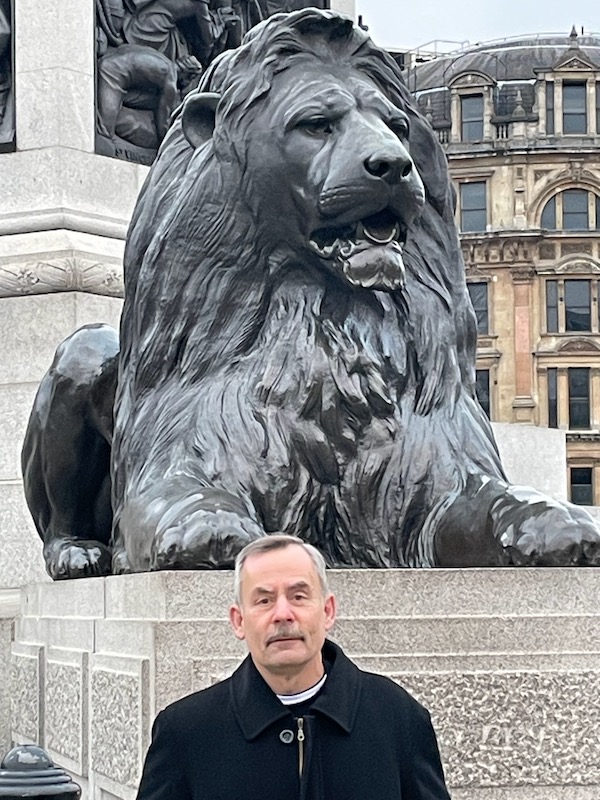
The Shipwrights Arms is a historical building from 1884 and is still a working pub.
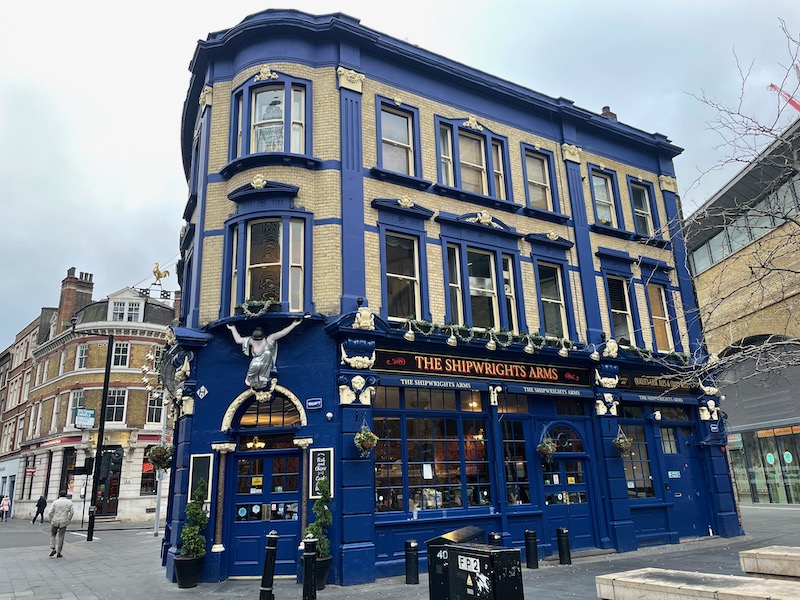
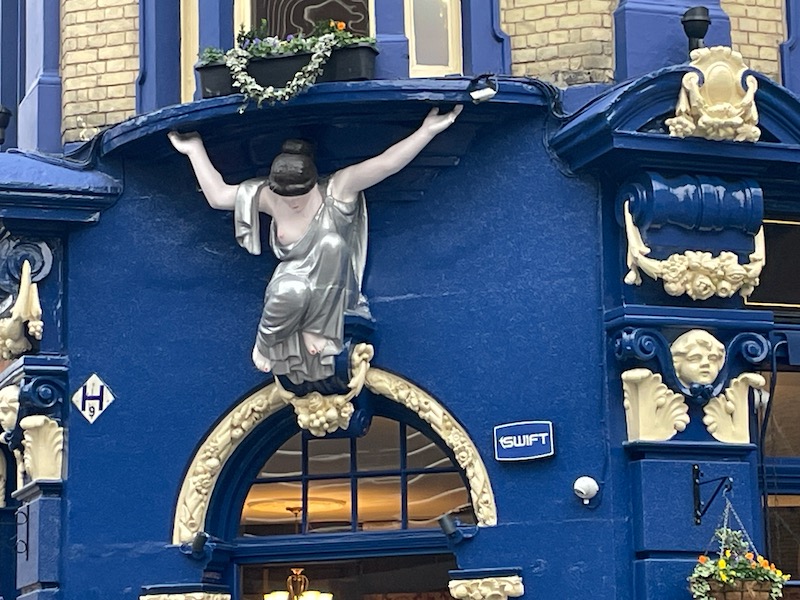
On our way to Shakespeare's Globe theater, we stopped at the Southwark Cathedral. London is a very old city, dating back to 50 AD with the Claudian invasion of Britain. At that time, the walled city was known as Londinium and was positioned roughly where the City of London is now, just across the Thames river from Southwark. Just outside of the Cathedral is a pit that shows the remnants of a Roman road, and then above that, the foundation of a Norman Priory from the 12th century.
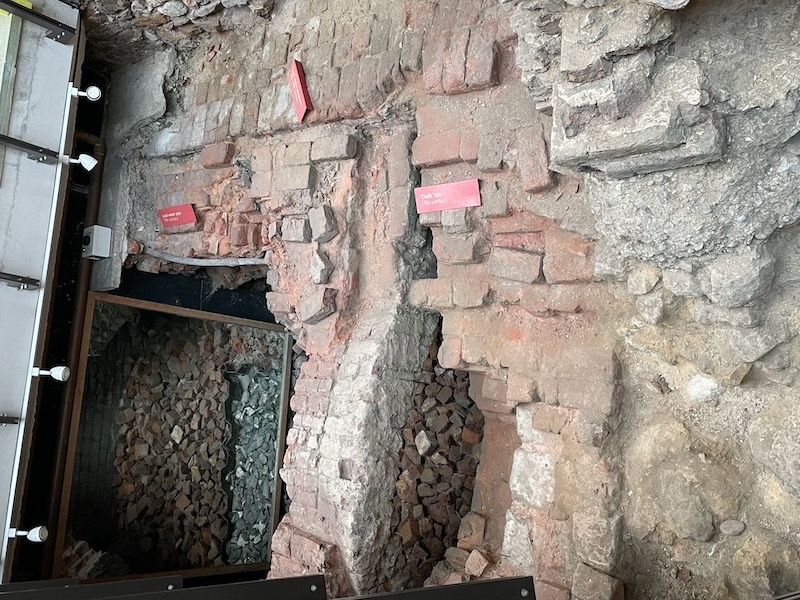
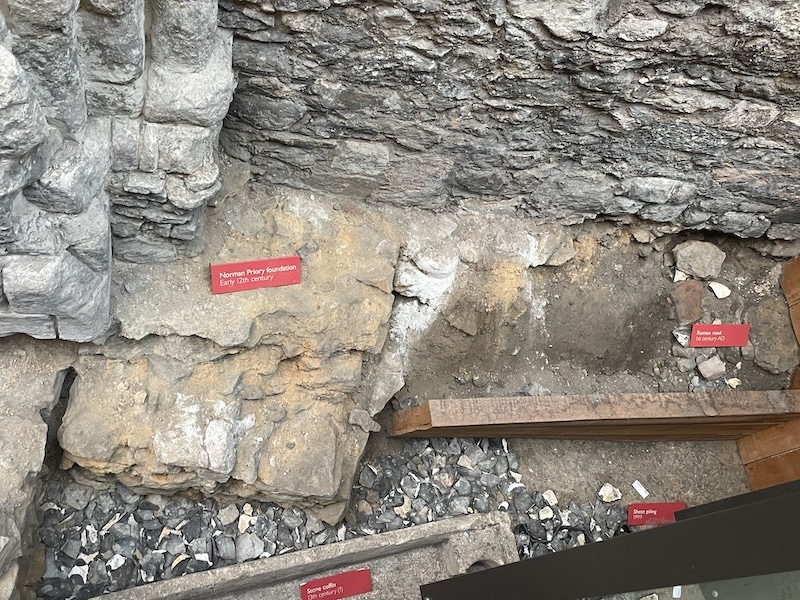
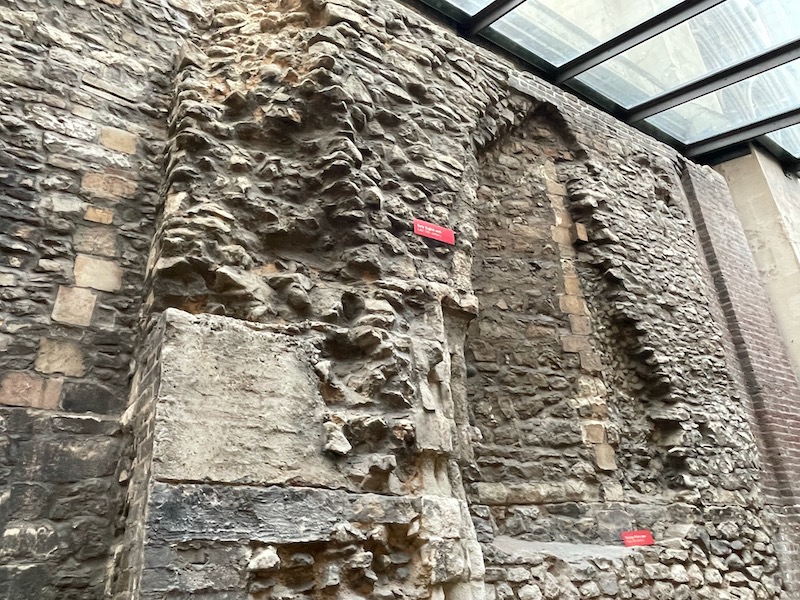
The original church here was built in 1106 and was an Augustinian Priory. The current church still has the Gothic structure, built between 1220 and 1420, but the nave is a bit more recent, redone in the 19th century, but still very Gothic.
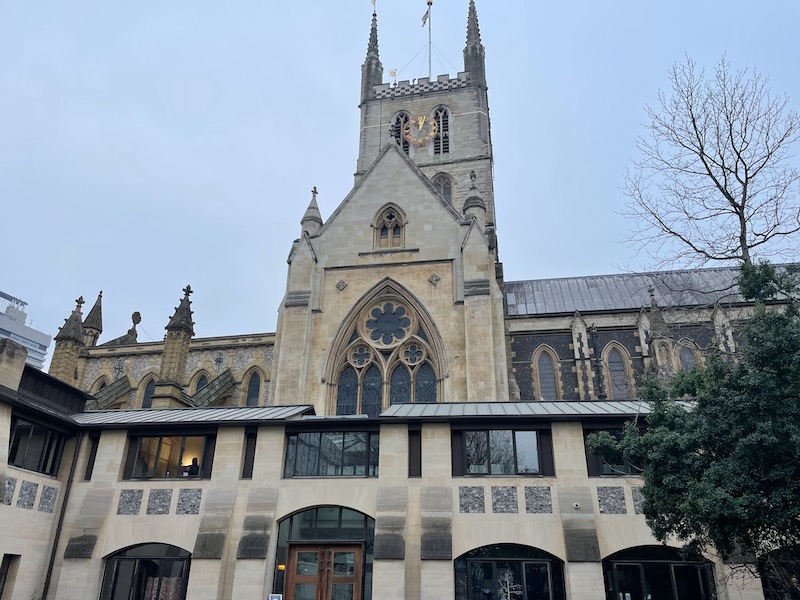
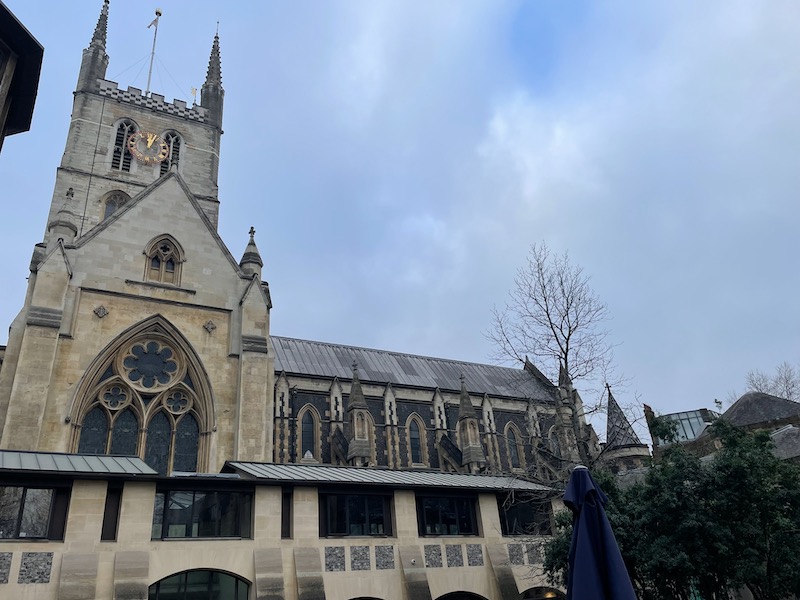
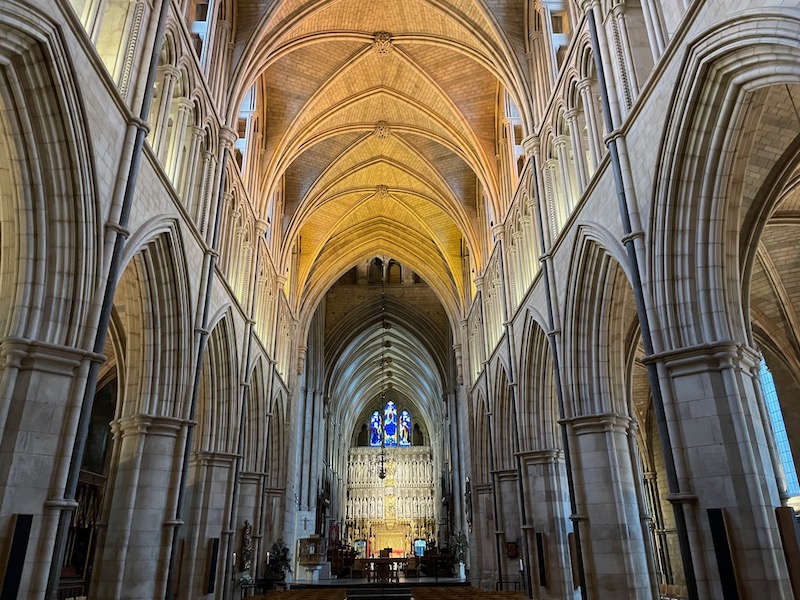
There are quite a few nice stained-glass windows here, most are composed of 3 lancet windows (a design from 1830 that were part of an attempt to return the church to its 13th century appearance).
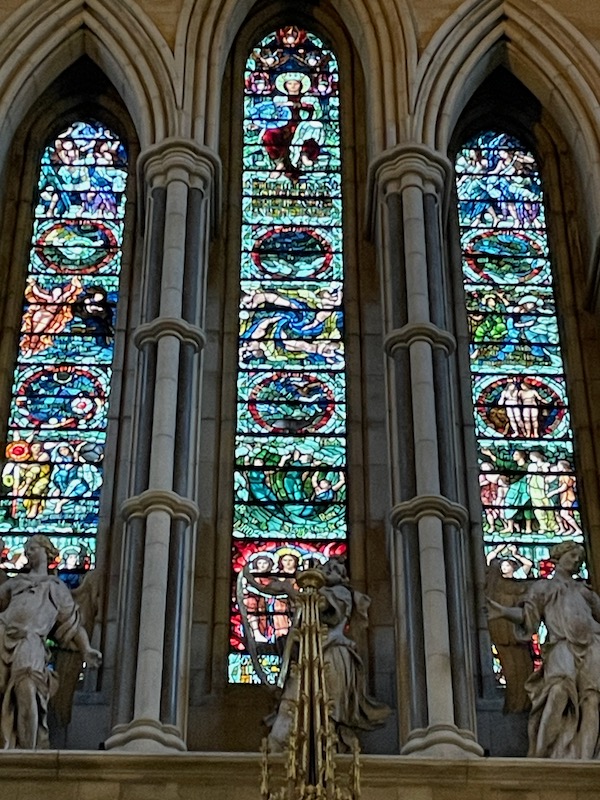
There is a large stained glass window dedicated to William Shakespeare, depicting scenes from his plays, at the base of which is an alabaster statue representing the playwright reclining, holding a quill.
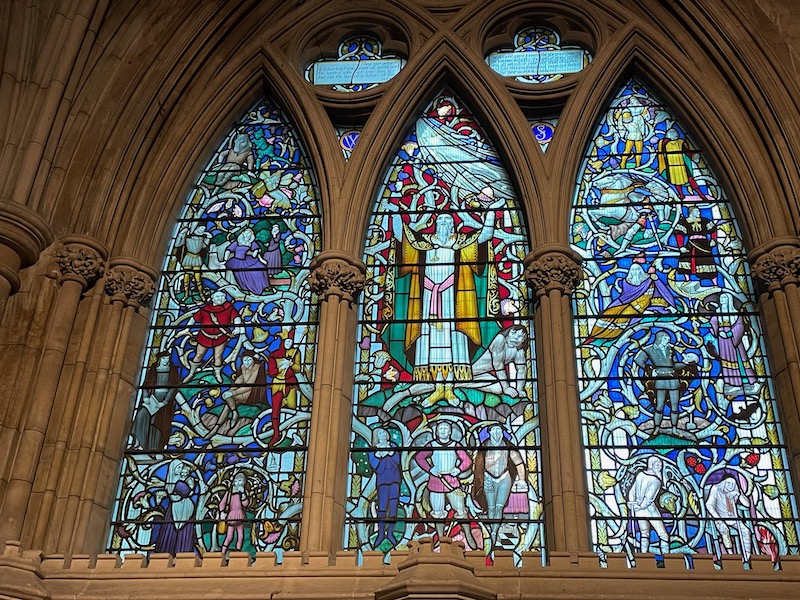
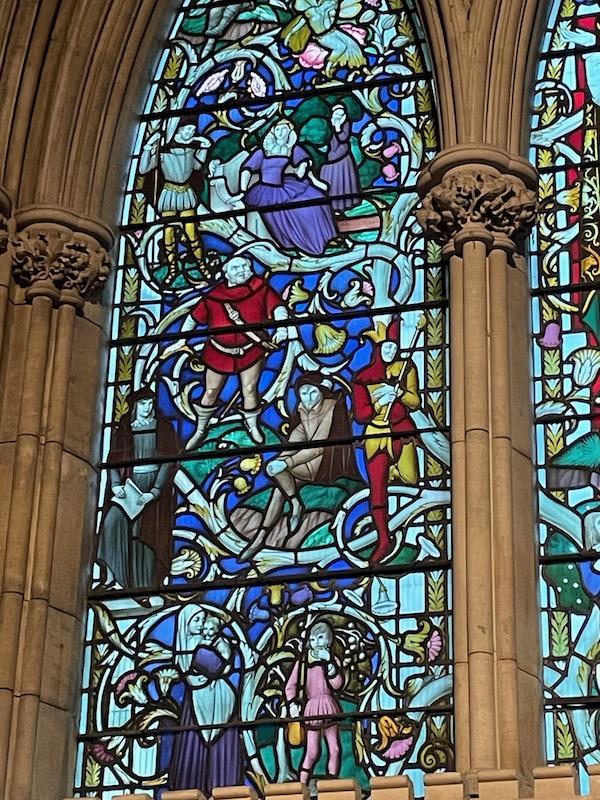
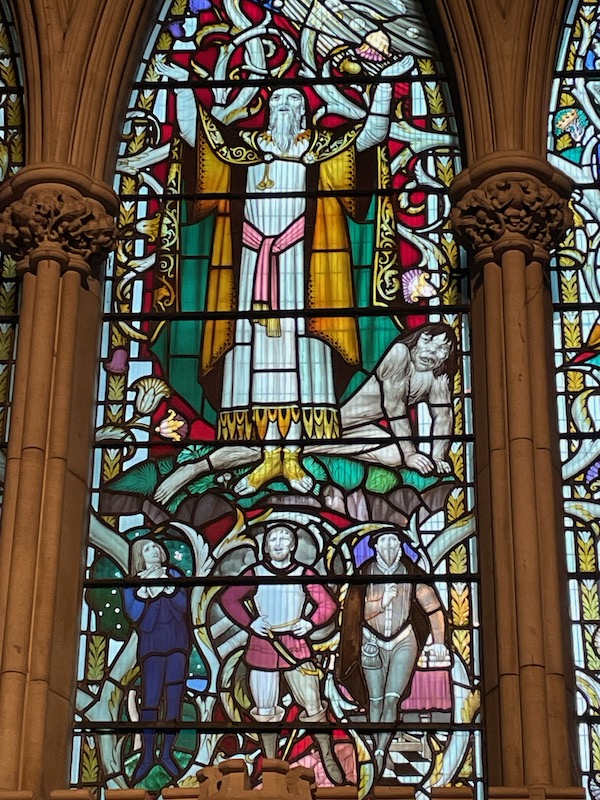
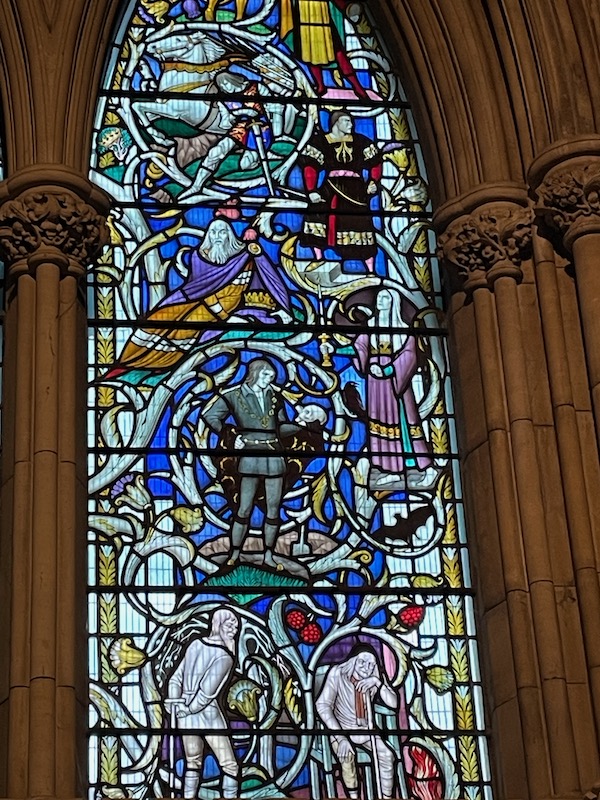
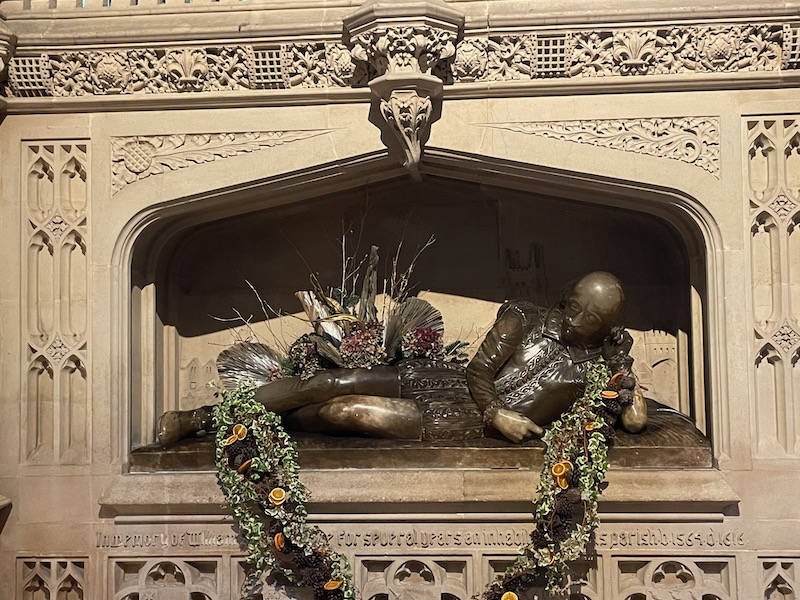
The high altar is one of the more elaborate that we've seen in England. The lower portion was gilded in 1930 and a new panel showing the Greek and Latin Fathers of the Church was added. This was inspired by a panel in St Mark's, Venice. The central figures of Christ in Majesty and the Blessed Virgin Mary with the Christ Child were gilded in the 1970s. Above that is a stone altar screen that was installed in 1520 and contains figures of saints and people connected with the history of the Cathedral. At the top is a nice stained-glass window .. not sure of the date but the style seems somewhat modern to me.
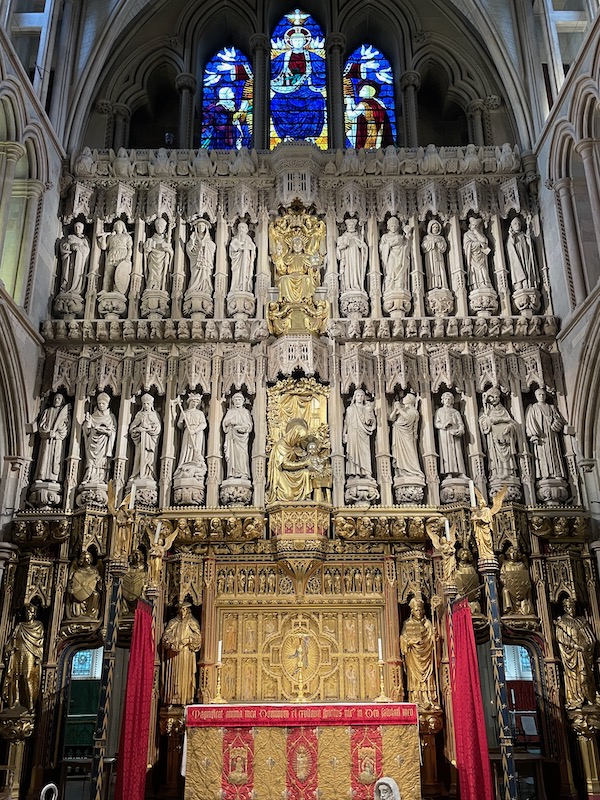
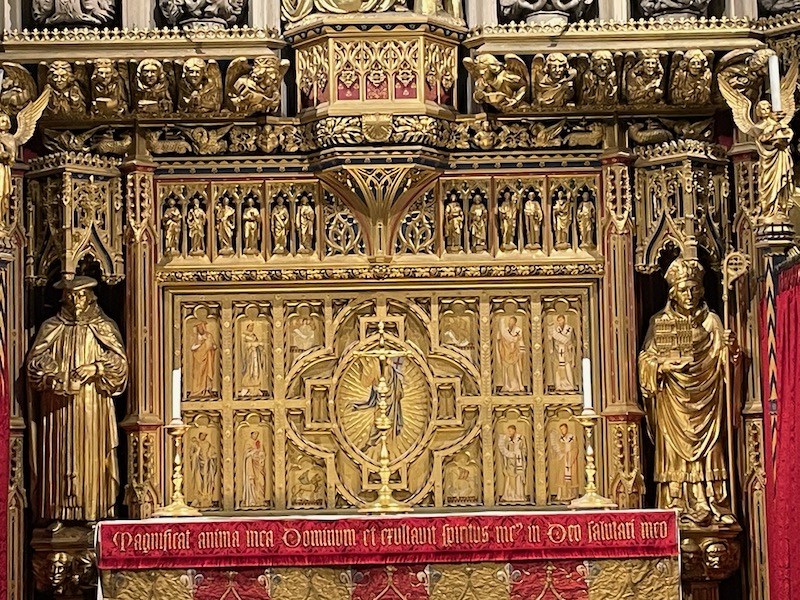
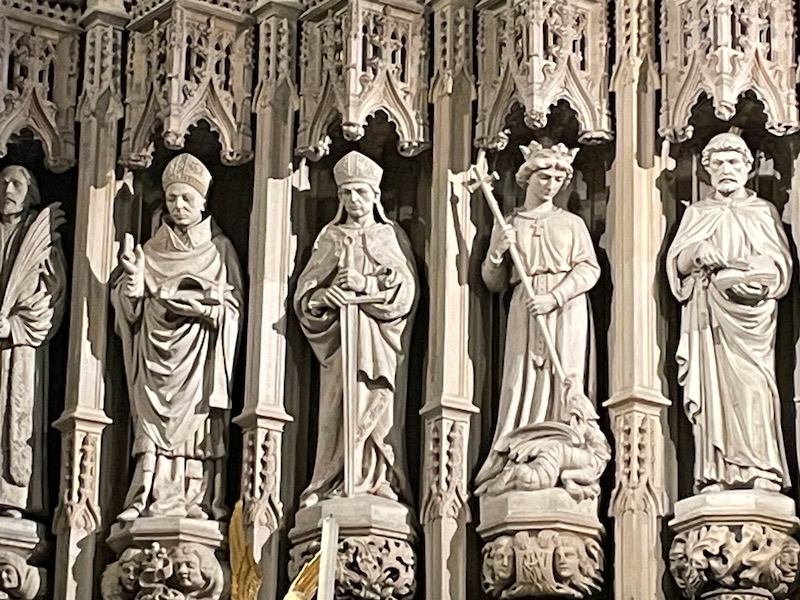
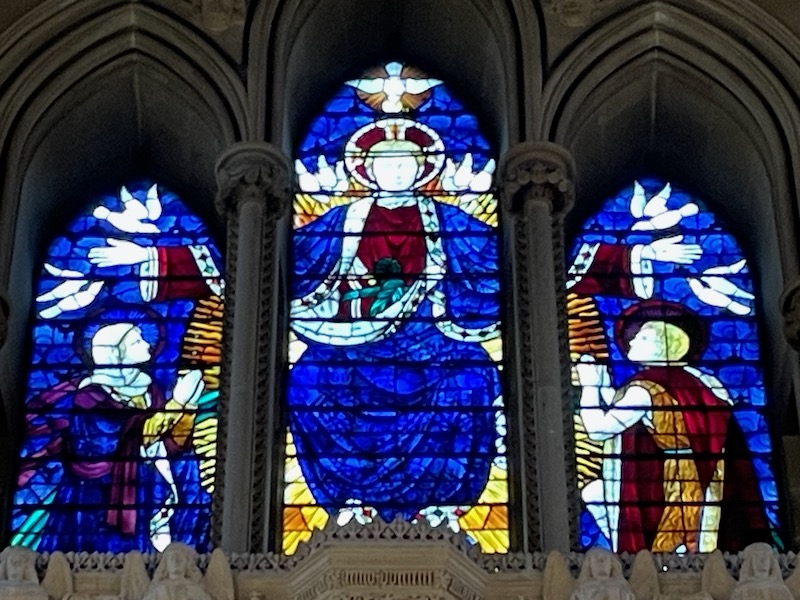
The Diamond Jubilee window was installed in 2012 to mark the Diamond Jubilee of Queen Elizabeth II.

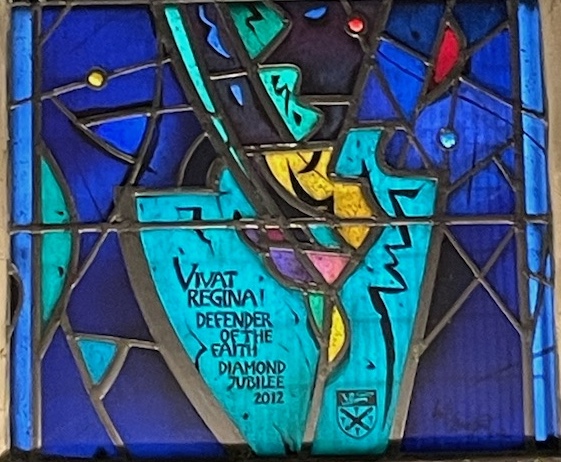
Behind the tall Gothic nave is the "Retro-Choir", which dates from the 13th century. There are 4 chapels there, dedicated to Saint Andrew, Saint Christopher, the Virgin Mary, and Saint Francis and Saint Elizabeth of Hungary. It is the earliest surviving example of Gothic architecture in London. An interesting bit of trivia: curing the reign of Queen Mary 1st, heresy trials were conducted here and several prominent figures being tried, condemned, and burnt to death.
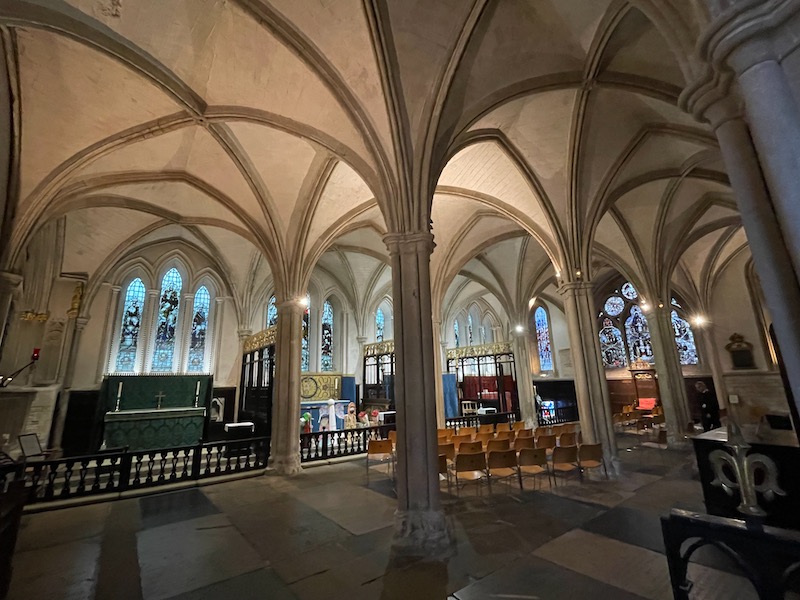
There are also several tombs or effigies there, including this carved wooden effigy from around 1280 making it one of the earliest wooden monumental effigies in England. It has been restored (which makes it look like bronze and not wood), but you can clearly make out the chain mail that he is wearing.
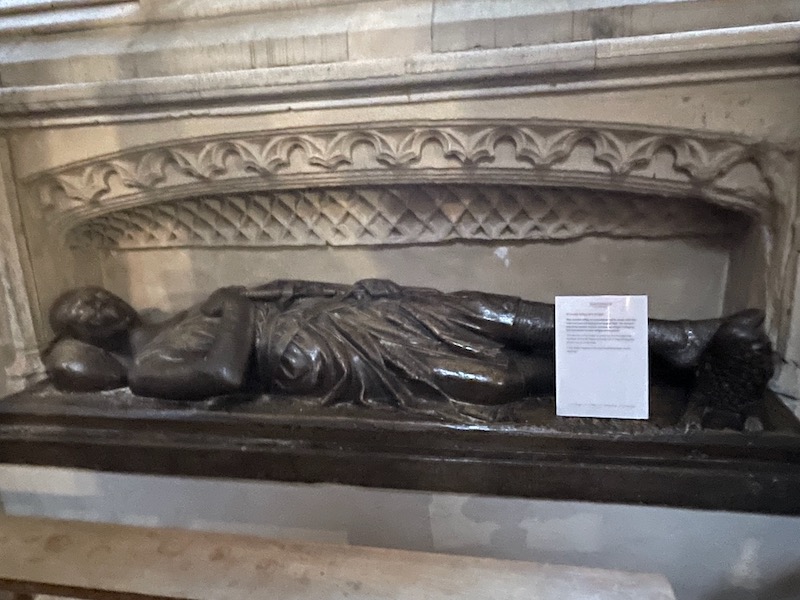

John Harvard, who founded Harvard University, was born nearby in 1607 and baptized here. The Harvard Chapel contains a stained-glass window that was given to the church in 1905 by the US Ambassador, Joseph Choate, and depicts the baptism of Christ.
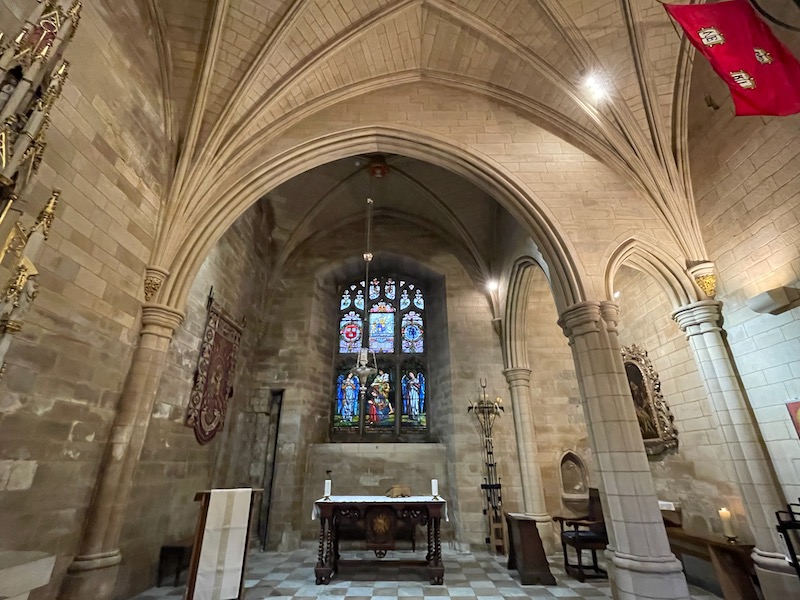
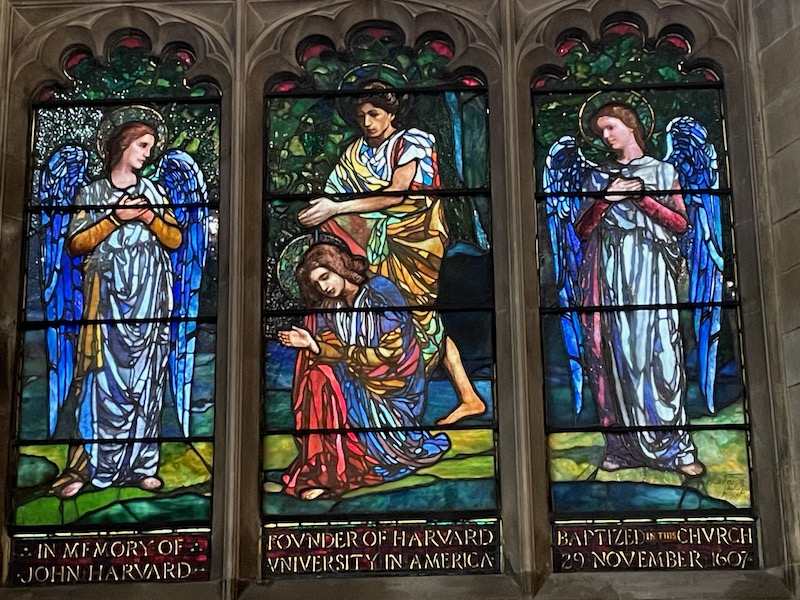
A set of mostly Baroque-style funeral monuments cover the walls of the North Transept.
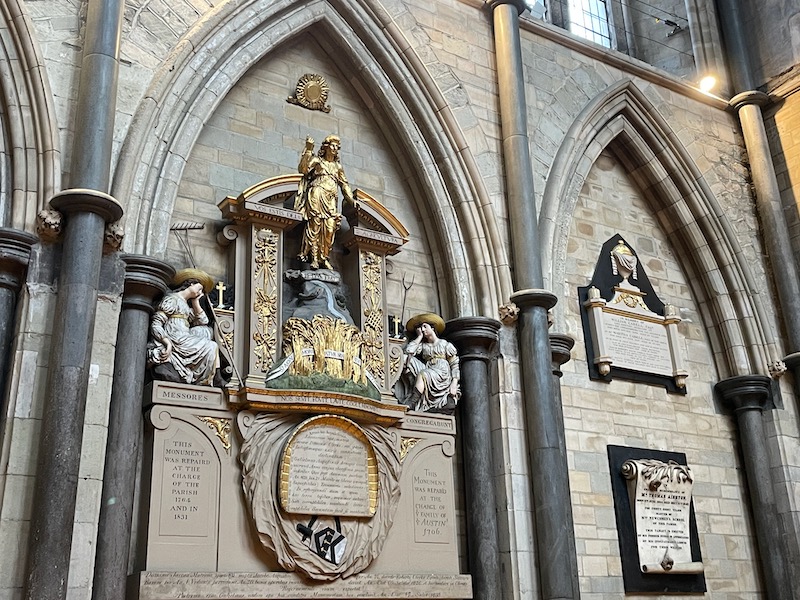
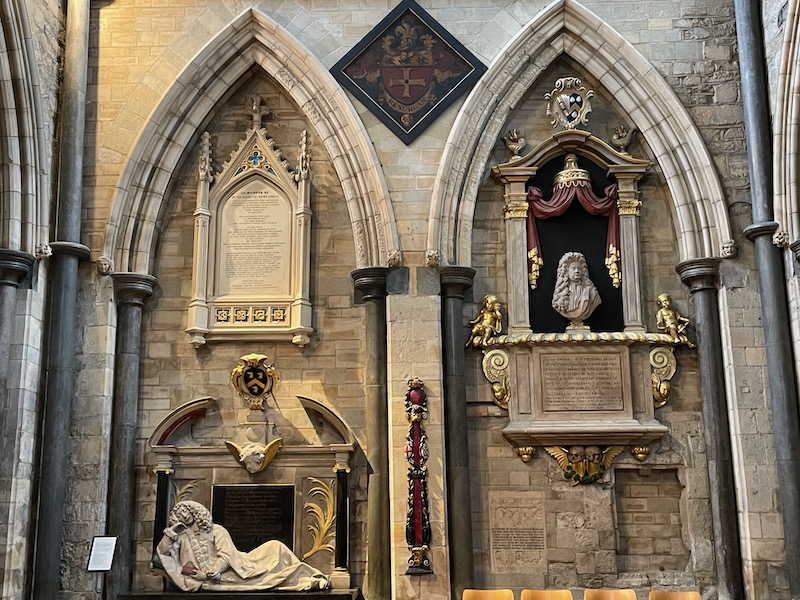
John Gower was a renowned poet in the 14th century and Poet Laureate to Kings Richard II and Henry VI. He had left money for a chapel which stood on the North side of the nave but that was destroyed many years ago. His tomb, built near to where his original chapel stood, shows Gower's head resting on his 3 most famous works. The bottom one, Confessio Amantis, is a collection of love stories including one that Shakespeare based "Pericles Prince of Tyre" on.

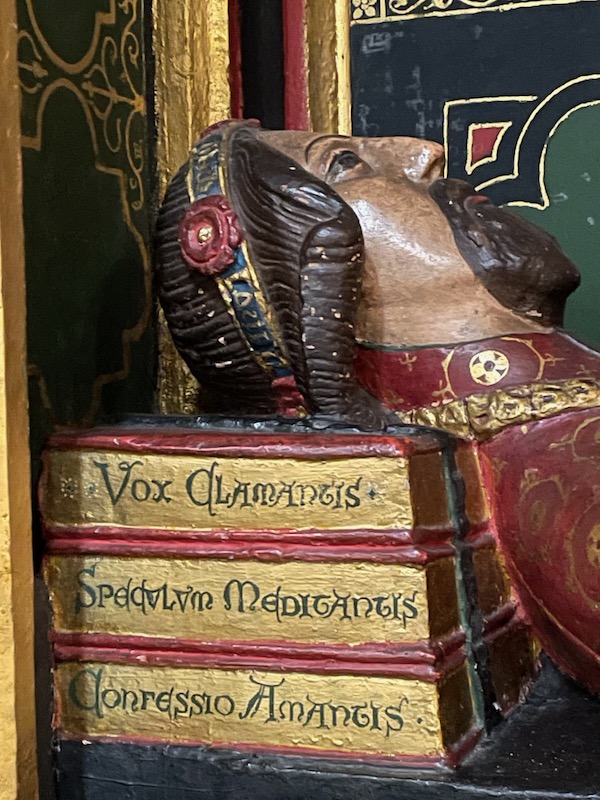
Along the Thames is a replica of the famous Golden Hind, which was used by Sir Francis Drake in his circumnavigation of the world between 1577 and 1580. A "hind" is a female red deer, which you can see the golden one on the front. This full-sized, sea-worthy replica was launched on 1973 and has traveled more than 140,000 miles since her maiden voyage in 1974-1975 from Plymouth England to San Francisco. It was also used in the making of the miniseries Shōgun.
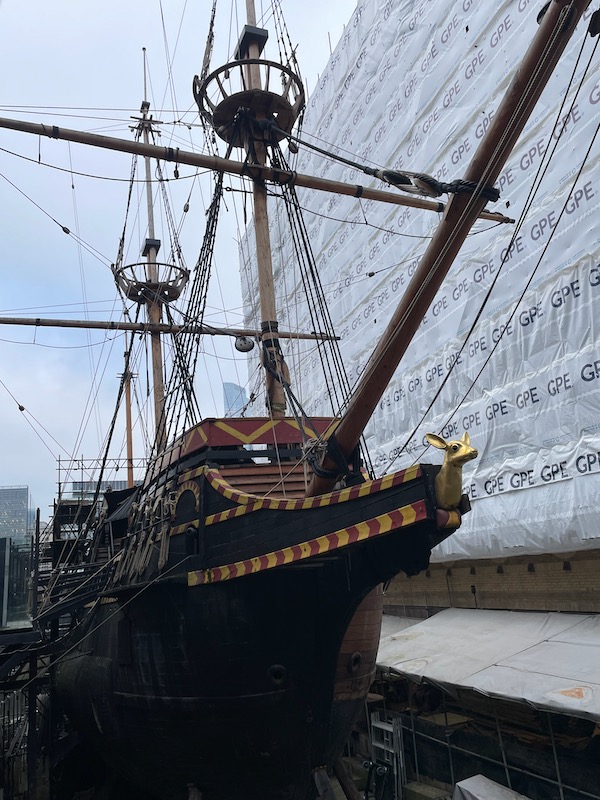
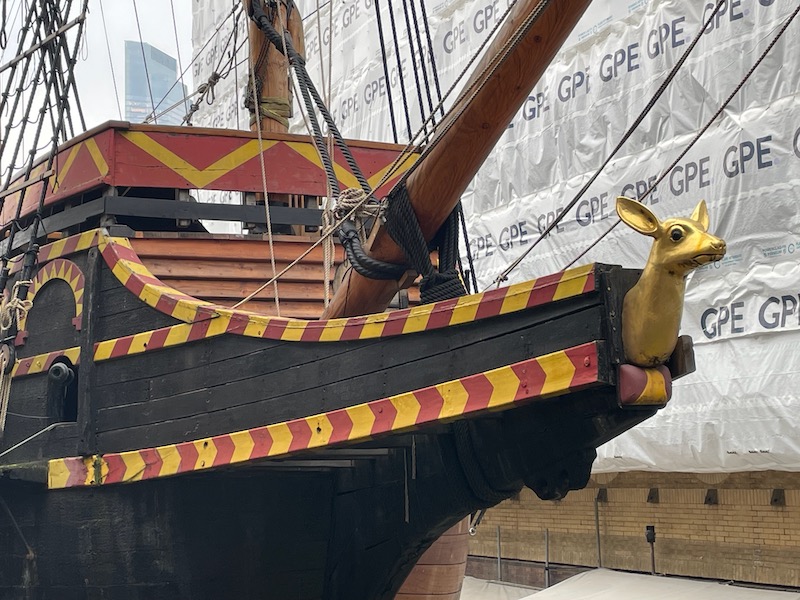
In the 12th century, Bishop Henry de Blois build a large palace here, which was one of the largest and most important buildings in medieval London. The portion visible here were part of the Great Hall, including the large rose window. The palace was used until the 17th century when it was divided into apartments and then mostly destroyed in 1814. It was mostly hidden by other development until it was "rediscovered" in the 19th century.
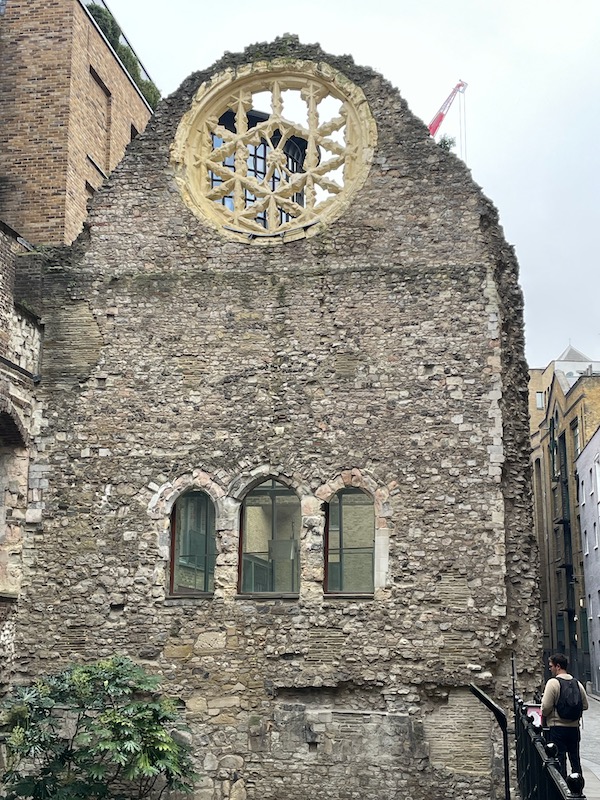
We finally made it to Shakepeare's Globe, a reconstruction of the original Globe theater that was used by William Shakespeare. The original theater was built in 1599, destroyed by fire in 1613, rebuilt in 1614, and then demolished in 1644. This reconstruction was based on evidence from the 1599 and 1614 buildings, along with modern safety requirements. It was built by Sam Wanamaker, the American actor and director. He left the US for England in the 1950's after becoming fearful of being blacklisted in Hollywood due to his communist views. He eventually returned to doing Hollywood films in the 1970's and 80's. In 1970, he was annoyed that while a number of replicas of the Globe theatre existed in the US, the site of the original in London was marked by only a plaque on a nearby brewery. He then made it his goal to create an exact replica of the Globe to feature plays and a museum. Unfortunately, he died in 1993, 3 1/2 years before the grand opening.
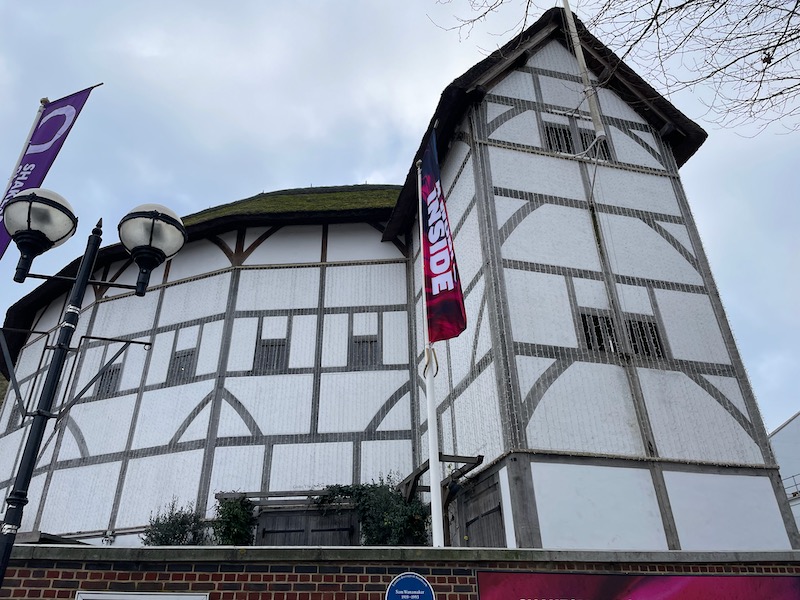
We signed up for a group tour but we were the only people at that time, so we got our own private tour (WOO HOO!). Here you can see the stage, which is raised a bit from the floor. On either side are a few "royal boxes", which were more to be seen than to see the show, since the angle from the boxes to the stage is really not that great. You can also see the painting decorations on the walls of the boxes, as well as behind the stage and the ceiling of the stage roof.
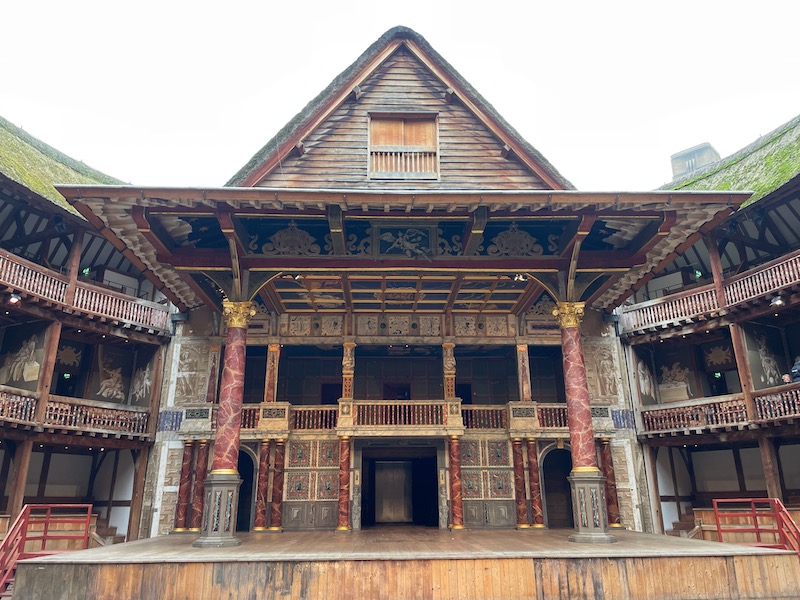
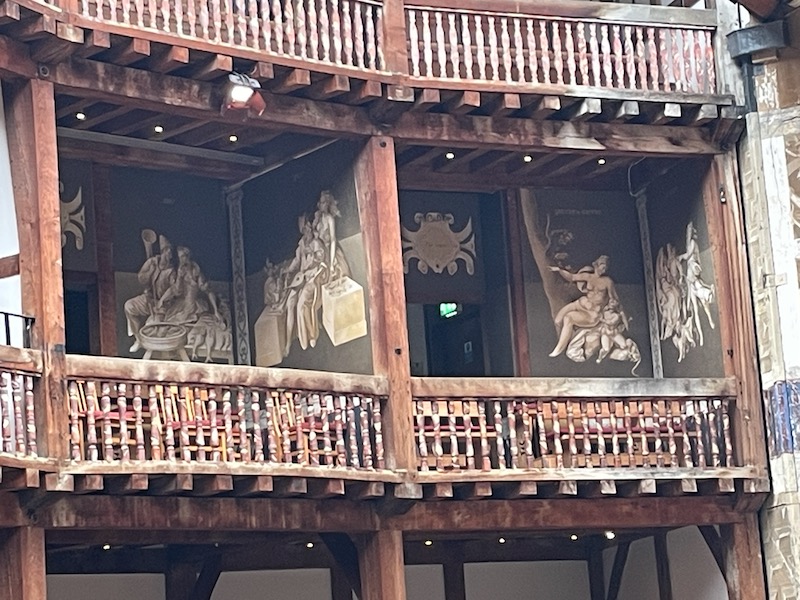
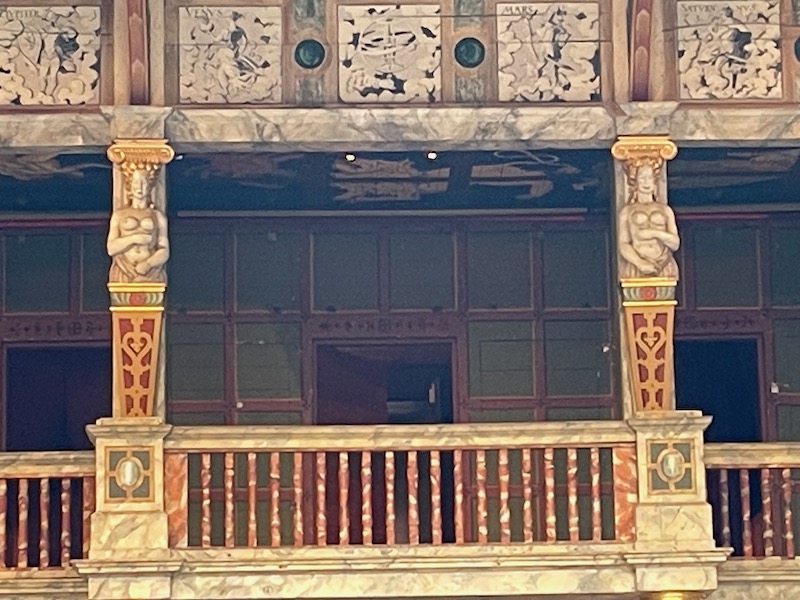
Speaking of the ceiling of the stage roof, the decoration is the signs of the zodiac. You can also see that there is a trap door visible which is normally closed.
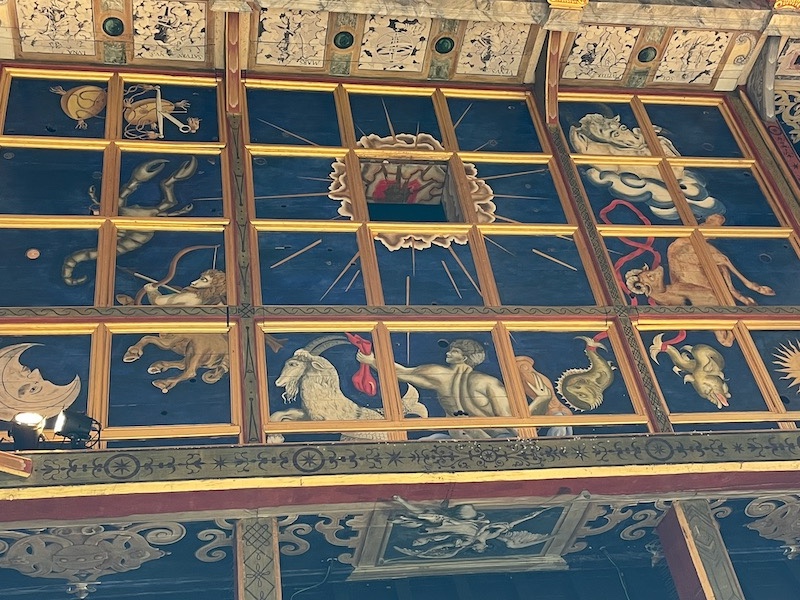
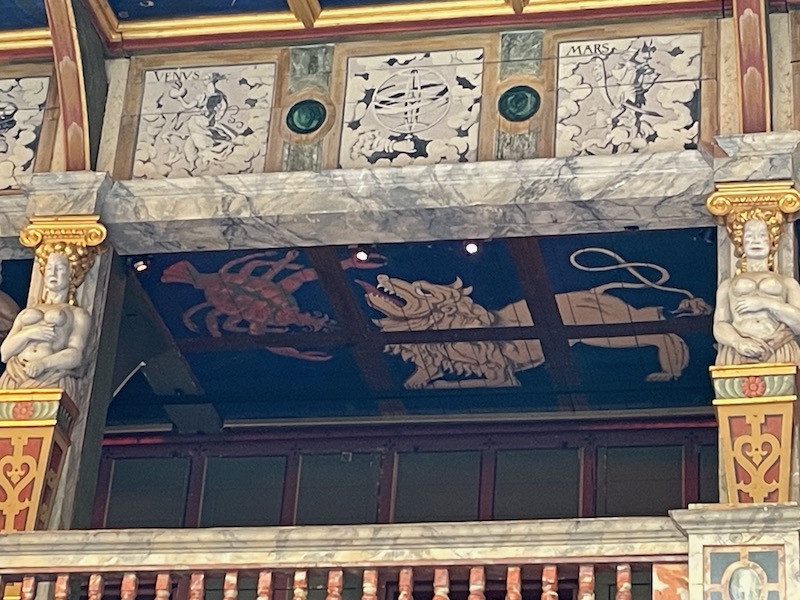
And here is the view from one of the royal boxes. As I mentioned, the view to the stage isn't as good as the seats directly in front, so this was more of a place to "be seen". The theater is open-air with a thatched roof over the seats. While most people would be sheltered from the rain, it isn't heated and the website clearly talks about being prepared for very hot and very cold temperatures during shows. In Shakespeare's time, the theater would have held double the number of people than it does now as you wouldn't have the various aisles, fire exits, and people would have stood on the floor in addition to those in seats.
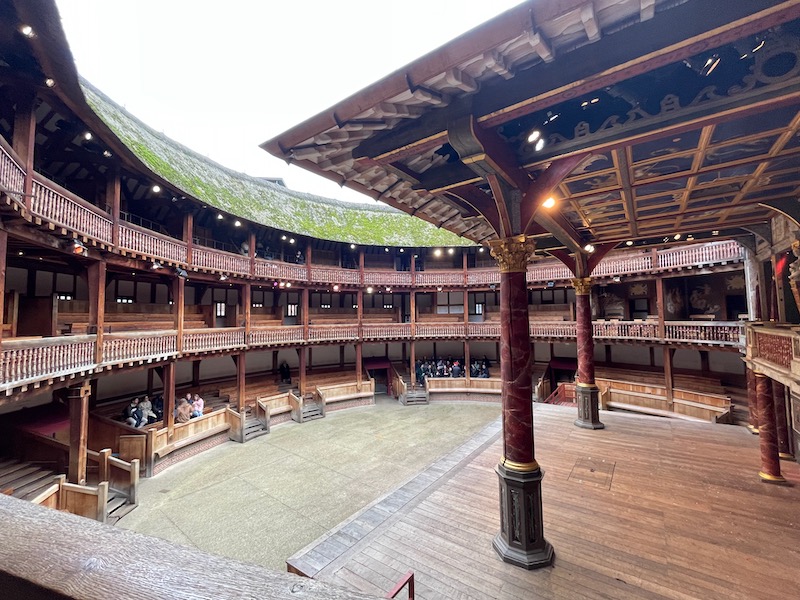
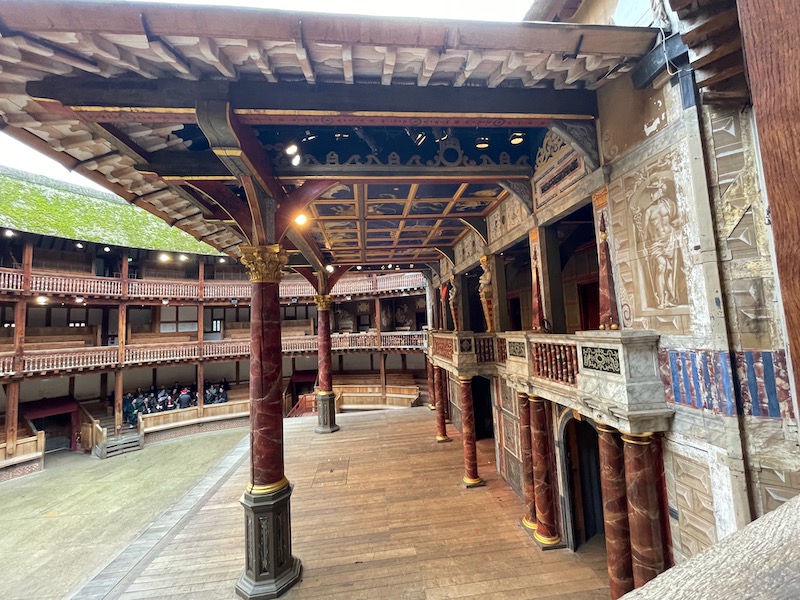
And a few with us in the box ... another benefit of a private tour!
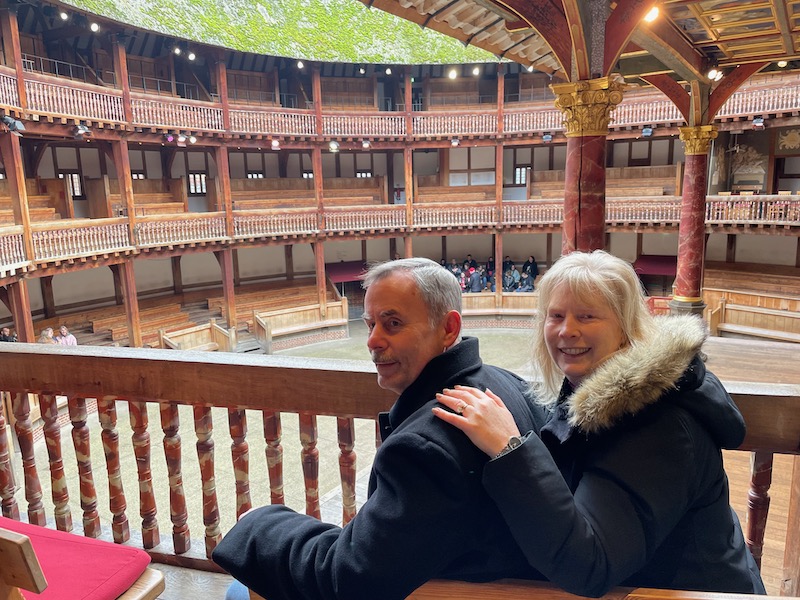
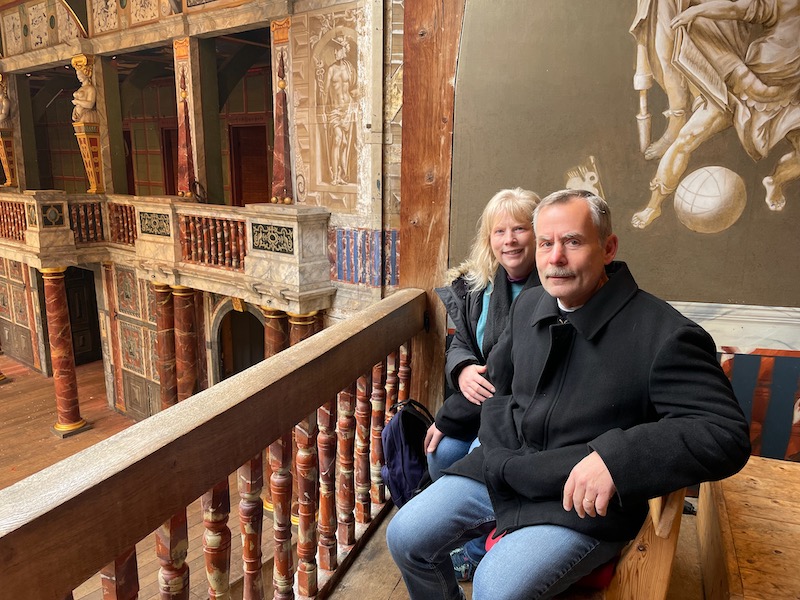
The museum that is next door (and part of the tour ticket) was quite interesting ... it had lots of information on the costumes, decorations, and set designs used. This, for example, was the costume that was designed and worn by Jane Lapotaire as Queen Elizabeth I in the Royal Gala Opening of the Globe Theater in 1997.
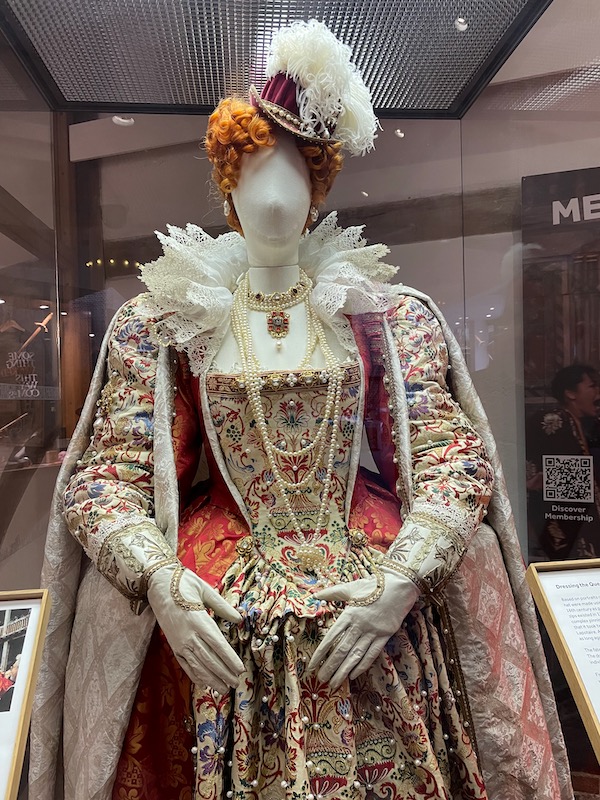
The Tate Modern, is a modern art museum that, interestingly enough, is housed in a former power station. Construction of the original building (called Bankside A) began in 1891 and operated until 1959 when it was demolished to build Bankside B, which then operated until 1981. In 1994, the Tate Gallery (which has 4 art museums) announced that the former power plant would house the Tate Modern, which opened in 2000. It is free to enter for a subset of the collection, so we popped in over lunch. Needless to say, it was a very quick visit since we are not the biggest fans of this type of contemporary art. Sometimes I think that "I" could do this, as some of the pieces are things like 3 student desks hung on a wall ... hmmmmm.
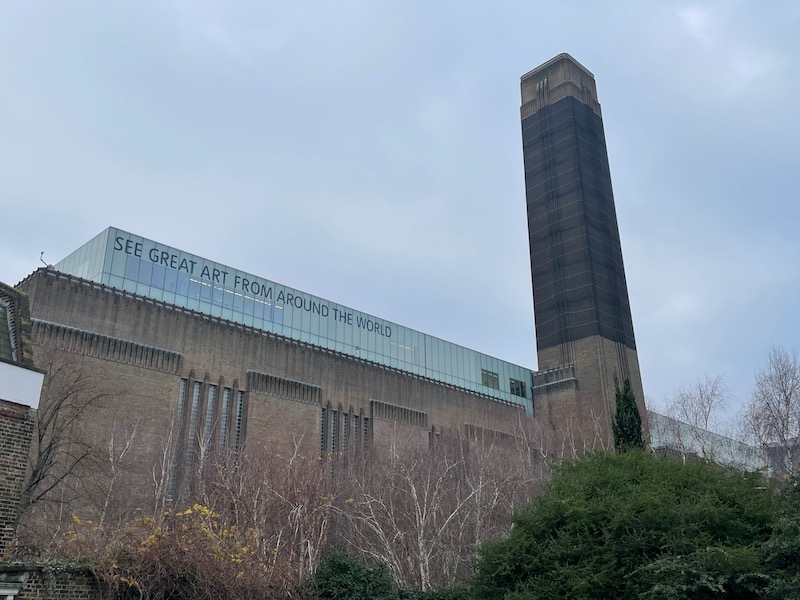
No longer operating, this badge of the London, Chatham, and Dover Railway caught my attention. It operated starting in 1860 until roughly 1917.
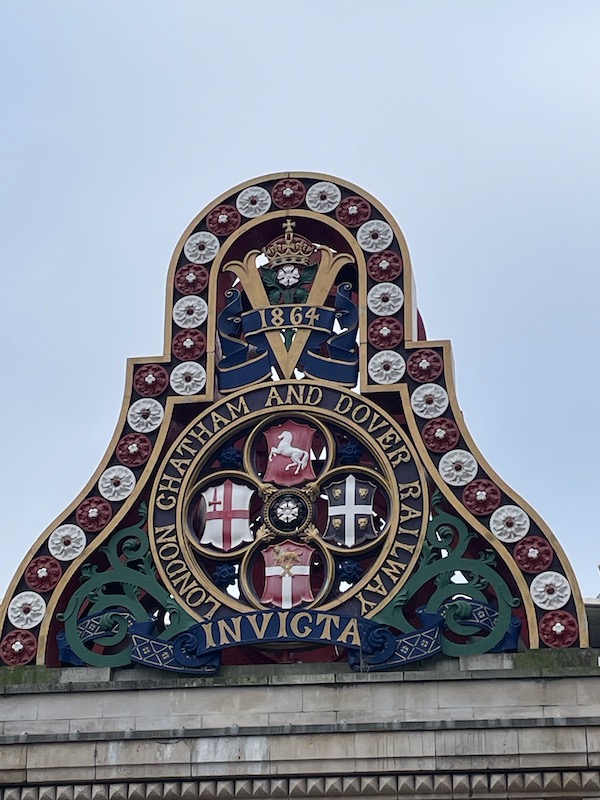
Our hotel was right next door to the St Martin-in-the-Fields church, which, at the time when the original church was built here, it was farmlands and fields beyond the London wall (hence the name). This church dates to around 1924, with the main entrance sitting up on a raised platform with 6 Corinthian columns supporting the pediment.
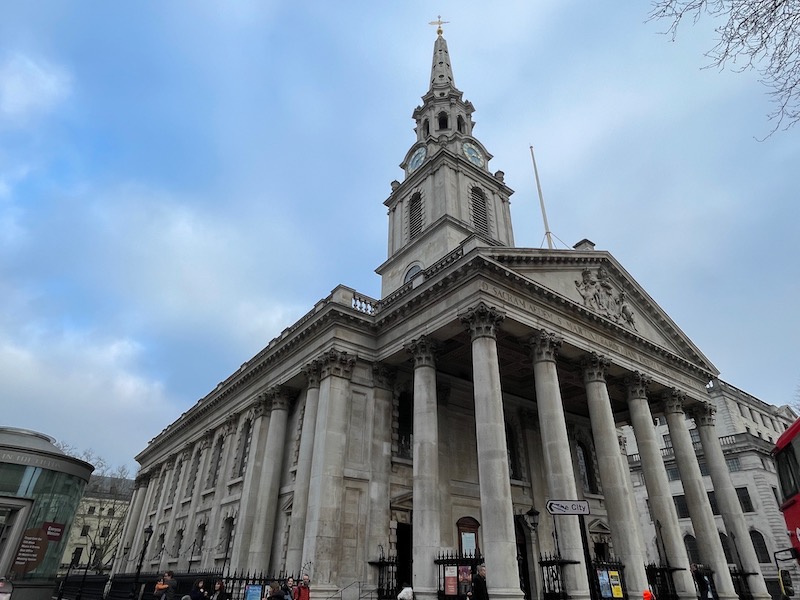
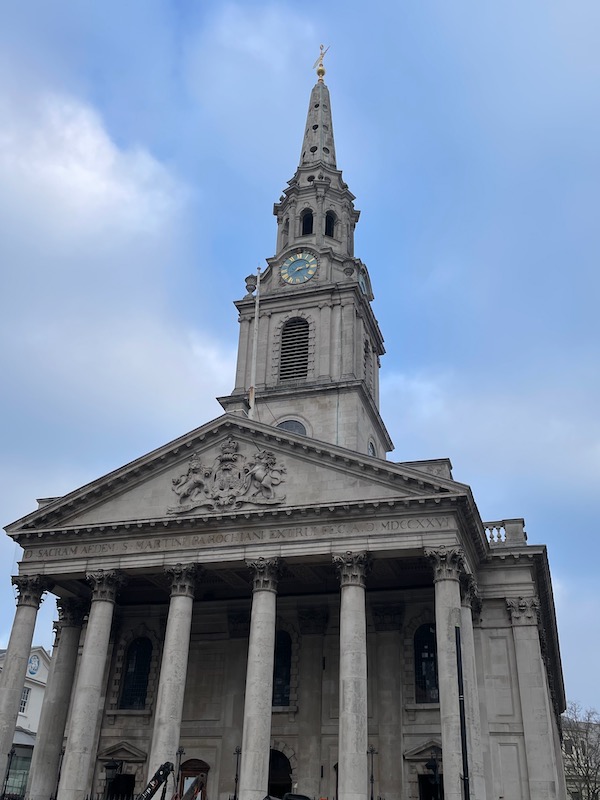
Inside, it looks like some of the churches that we saw in Boston and Philadelphia. The nave ceiling is a flattened barrel vault, divided into panels by ribs. The panels are decorated in stucco with cherubs, clouds, shells and scroll work. The most unique part is the large East window, which was added in 2008. The glass, held within a stainless steel framework, is made of mouth-blown clear glass panels etched on both sides with a subtle, feathery pattern. The design combines, through line only, the shape of Christ on the Cross with an eclipse of light at its centre.
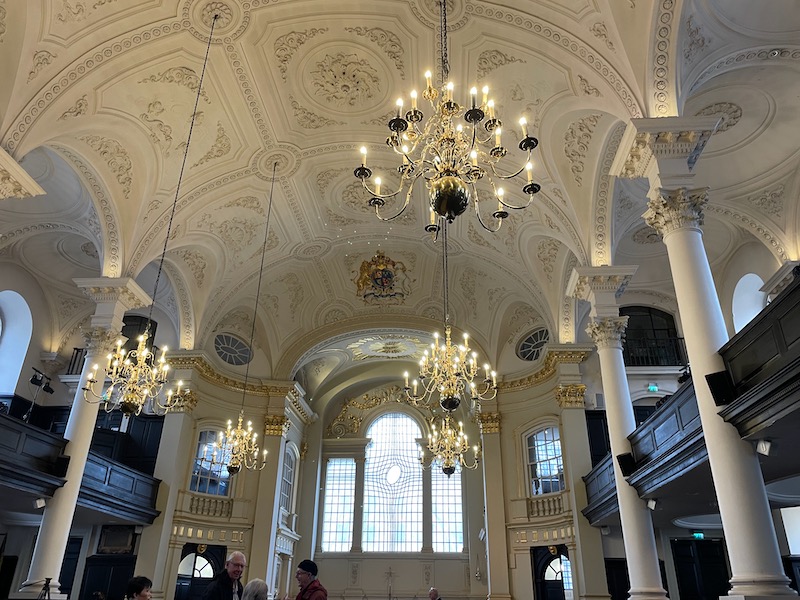
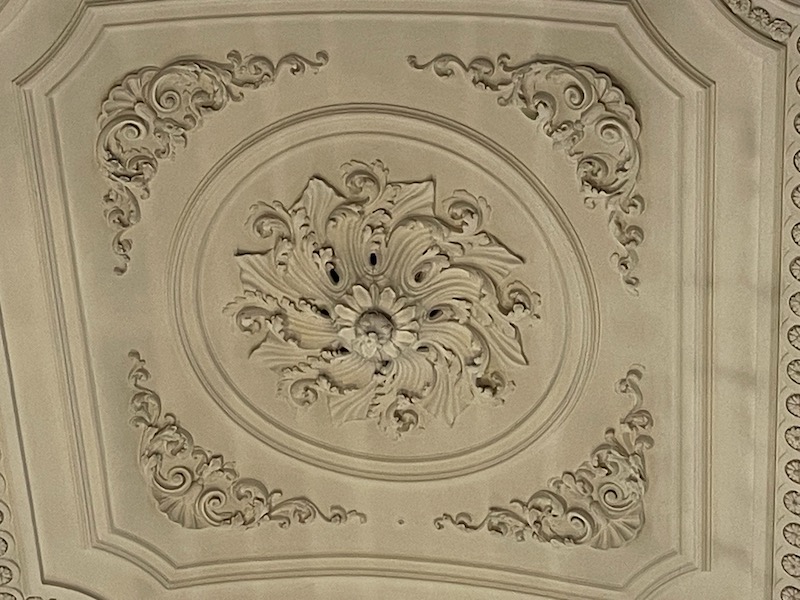
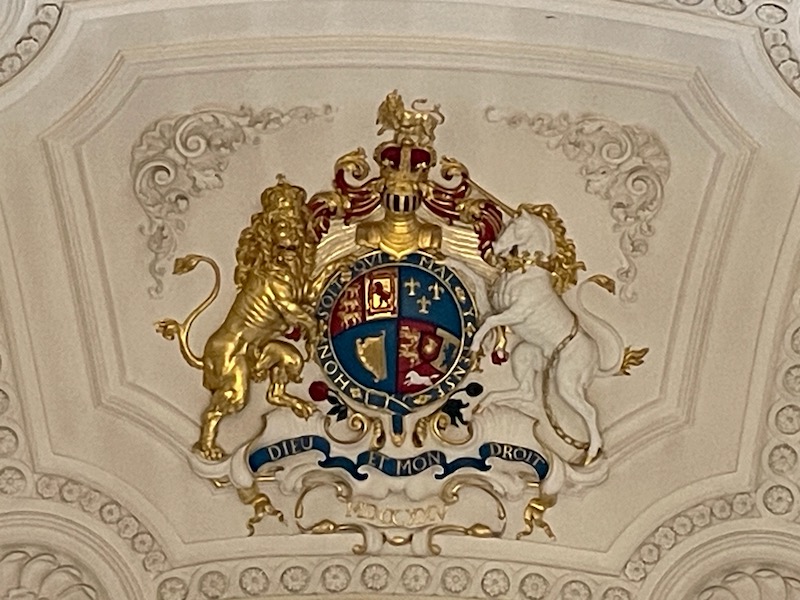
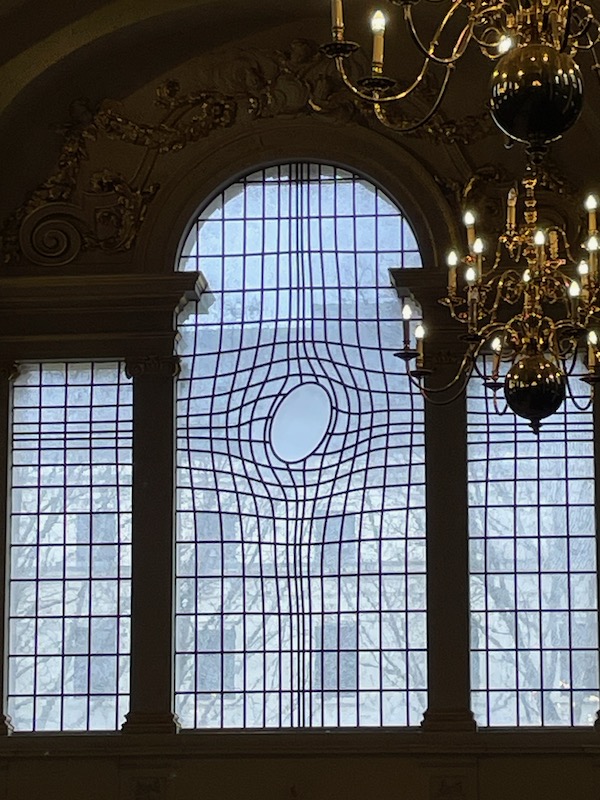
Drinks tonight were a couple cocktails at an Indian restaurant ... we find that wine and Indian food don't really mix well.
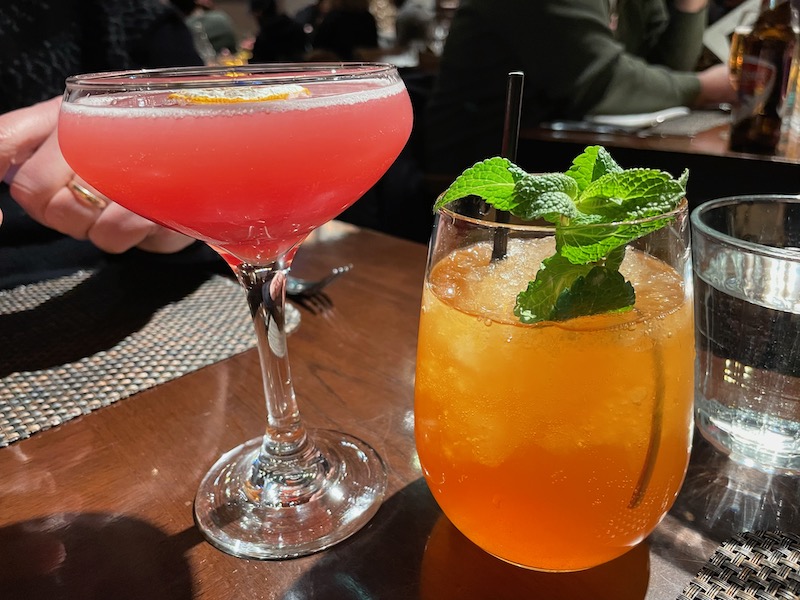
Saint Martin's Theater has been showing Agatha Christie's The Mousetrap since 1974. The theater itself opened in 1913 as one of a pair of theaters owned by the 19th Baron Willoughby de Broke and it is still owned by Lord Willoughby de Broke and his family. It was a very different show than Back to the Future the Musical! We made sure that we didn't read up on the plot of the play beforehand, and it was really interesting.
